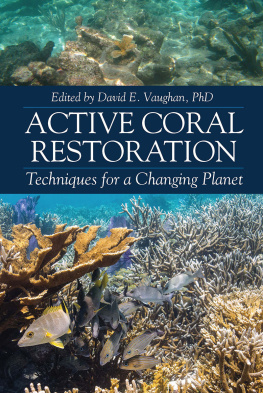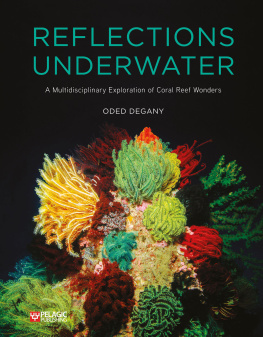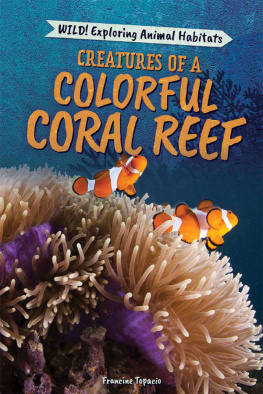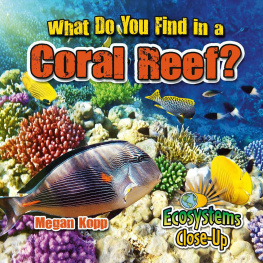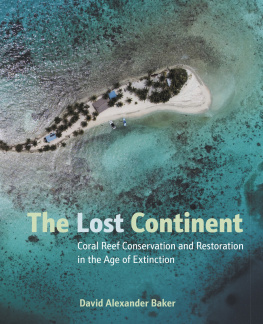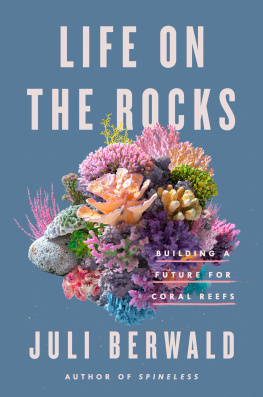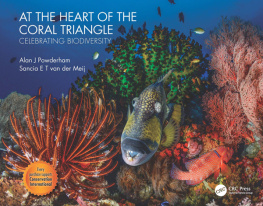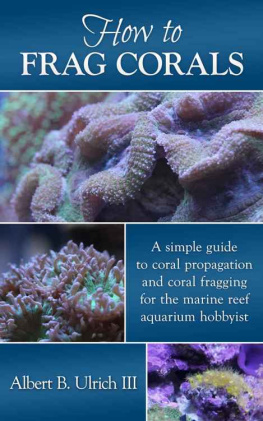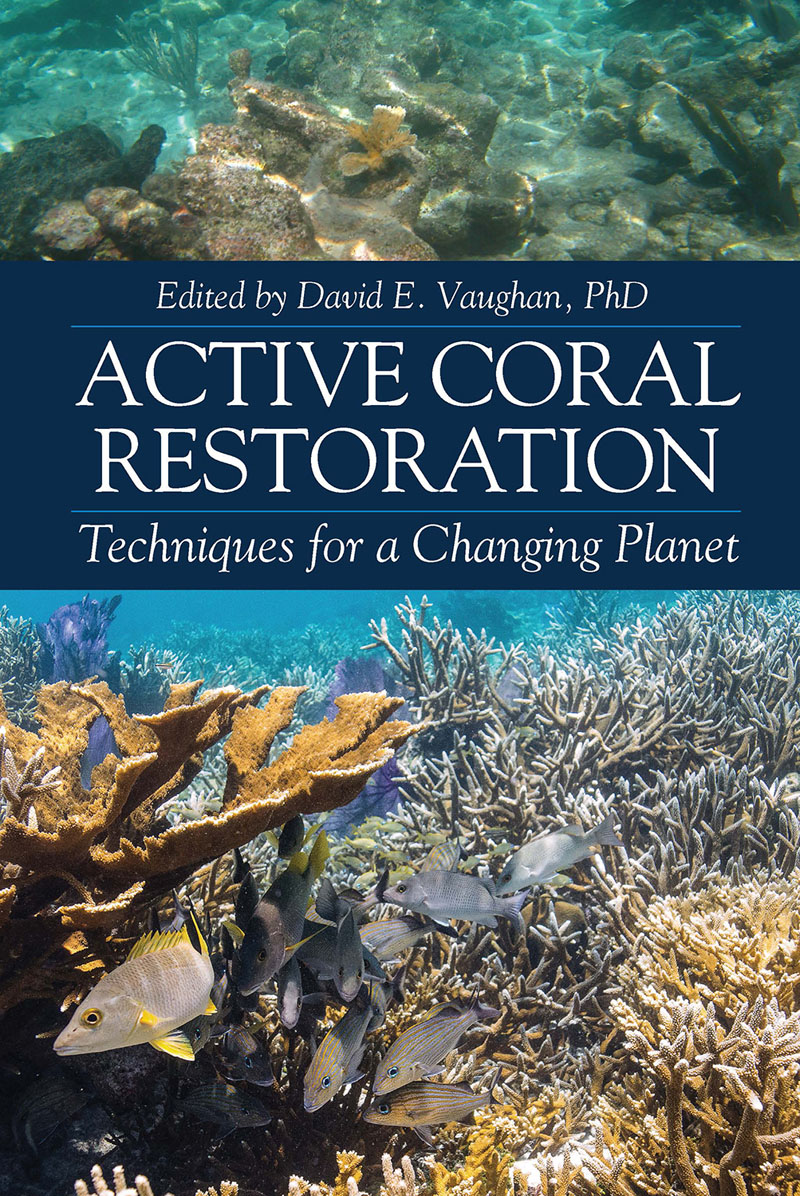
Copyright 2021 by J. Ross Publishing
ISBN: 978-1-60427-143-0
Printed and bound in the U.S.A. Printed on acid-free paper.
10 9 8 7 6 5 4 3 2 1
Library of Congress Cataloging-in-Publication Data
Names: Vaughan, David E., editor.
Title: Active coral restoration : techniques for a changing planet / edited by David Vaughan.
Description: Plantation : J. Ross Publishing, Inc., [2021] | Includes bibliographical references and index. |
Identifiers: LCCN 2021006281 (print) | LCCN 2021006282 (ebook) | ISBN 9781604271430 (hardcover) | ISBN 9781604278323 (epub)
Subjects: LCSH: Coral reef restoration.
Classification: LCC QH541.5.C7 A28 2021 (print) | LCC QH541.5.C7 (ebook) | DDC 333.95/53153dc23
LC record available at https://lccn.loc.gov/2021006281
LC ebook record available at https://lccn.loc.gov/2021006282
Cover photo credit:
Thank you to Lisa Carne, Executive Director and Founder of Fragments of Hope, Ltd., for the photos on the front cover. The top photo is from October 2011 and shows degraded reef rubble with the first coral outplants of Acropora palmata, elkhorn coral, at sub-site #13 in Laughing Caye National Park, Belize. The bottom photo is of the same site in May 2016. Through active coral restoration, conducted by Fragments of Hope, this reef was successfully restored to a functional reef teeming with fish and invertebrates in just six years. Our gratitude to Lisa and her colleagues for sharing these photos, for telling their story in of this book, and for their continued dedication to coral reef restoration.
This publication contains information obtained from authentic and highly regarded sources. Reprinted material is used with permission, and sources are indicated. Reasonable effort has been made to publish reliable data and information, but the author and the publisher cannot assume responsibility for the validity of all materials or for the consequences of their use.
All rights reserved. Neither this publication nor any part thereof may be reproduced, stored in a retrieval system, or transmitted in any form or by any means, electronic, mechanical, photocopying, recording or otherwise, without the prior written permission of the publisher.
The copyright owners consent does not extend to copying for general distribution for promotion, for creating new works, or for resale. Specific permission must be obtained from J. Ross Publishing for such purposes.
Direct all inquiries to J. Ross Publishing, Inc., 151 N. Nob Hill Rd., Suite 476, Plantation, FL 33324.
Phone: (954) 727-9333
Fax: (561) 892-0700
Web: www.jrosspub.com
In memory of Dr. Ruth Gates, whose energy, enthusiasm, and dedication to the study and conservation of coral reefs has been a true inspirationone that will lead us forward well into the future.
CONTENTS
FOREWORD
Philippe Cousteau Jr.
If there is a Garden of Eden on earth this must be it, I thought to myself as I stared in awe at the spectacle in front of me. It was a bright summers day and I was floating in crystal clear water some 40 feet below the surface in front of a coral reef called Shab Rumi, a few hours boat ride off the coast of Sudan in the Red Sea. Every color imaginable could be seen stretching out along the contours of the reef. Fish of every shape and size, from gobies no larger than the head of a pencil to enormous groupers and shimmering reef sharks, darted all around me while enormous sea fans and sponges dotted the landscapeit was one of the most awe-inspiring things I had ever seen.
Of course, growing up exploring the ocean, I had seen many coral reefs before, but this one was special. Tragically, in just a few short decades, most reefs around the world, from the Caribbean to the Great Barrier Reef, had become a shadow of their former selves. This reef was different, due to its remoteness and the advantage it had by having evolved in such a historically warm body of waterit was thriving. For me, it was the first time I had ever seen a reef that was not ravaged by the effects of climate change, pollution, ocean acidification, destructive fishing, or a combination of all four.
Whenever I think back to that day when I was diving on Shab Rumi more than ten years ago, I am reminded of whats at stake. Though most reefs in the Red Sea are still thriving, that is not the case throughout the rest of the world. Indeed, coral reefs today continue to decline around the world and the critical function they play in maintaining a healthy ocean ecosystem continues to falter. Coral reefs, which cover less than 1% of the worlds ocean (an area about the size of the U.S. state of Nevada) support nearly 25% of all known marine species. Their role in protecting shorelines, providing food to hundreds of millions of people, and as a source of important medical breakthroughs is vital not only to the health of the ocean but to the health of humanity as well. Despite all this, we have lost more than 40% of the worlds coral reefs and it is estimated that, at the current trajectory, we may lose 90% by the middle of this century.
But there is good news, too, and that is why this book is so important. In the same way that humans are responsible for the destruction of these precious ecosystems, we can also become their saviors. This excellent book, edited by my dear friend Dr. David Vaughan, features both his ground-breaking work, as well as a collection of insights by a whos who in the coral restoration world. Starting with the early developers such as Austin Bowden-Kerby in the Caribbean, Buki Rinkevich in the Red Sea, and Ken Nedimyer in Florida and the Caribbean, it also includes many new and upcoming scientists who have forged reputations in their own areas of expertise such as technological innovation, genetics research, and assisted evolution. This clearly and inspiringly laid-out manual is a practical guide for todays practitioner as well as a roadmap for the future.
But, in some ways it is more than an exploration about active coral reef restoration; it is a guide for humanity to remind us that through innovation and determination, we can play an active role in returning the ocean to abundance. I have known Dave for 20 years and I continue to marvel at his dedication, humility, and brilliance. This book is a must-read for anyone interested in the exciting world of active coral reef restoration. This work proves that these Gardens of Eden need not be lost and that there is always hope for the future.
ABOUT THE EDITOR
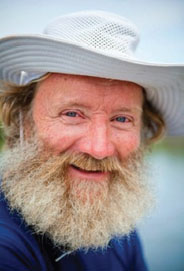
Photo credit: Ian Shive
Dr. David E. Vaughan has held positions in aquaculture research and development for over 30 years. He directed the Aquaculture Division at the Harbor Branch Oceanographic Institution (HBOI) for 17 years, including the design, build, and operation of the 60-acre HBOI Aquaculture Development Parkthe worlds only completely recirculating center for aquaculture training and demonstration. He is often cited with creating the R&D and scale-up of clam-farming technologies in Florida, and directing the training programs and operations of the nations largest hatchery to produce clams that are used for the retraining of displaced fisherman. He founded and developed Oceans, Reefs, and Aquariums Inc. (ORA), a large marine ornamental production facility for producing thousands of reef fish as well as hard and soft corals for the aquarium trade. He also worked with Philippe Cousteau at Earth Echo International on international coral reef restoration initiatives.
Next page
